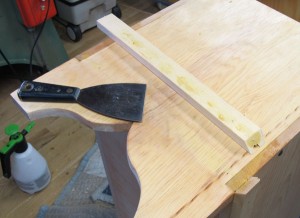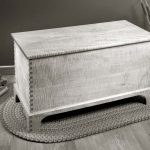We may receive a commission when you use our affiliate links. However, this does not impact our recommendations.
Whenever I talk about glue to clubs and classes, I hand around a bottle of liquid hide glue and ask them to tell me what its disadvantages are.
“It’s weak.” Actually no, it produces a bond stronger than the wood itself.
“It stinks.” Hide glue smells only as bad as a wet rawhide chew toy. It’s not bad at all.
“It is sensitive to heat and moisture.” Ah, but that is its strength. Because of this characteristic, you can reverse its bond with a heat and moisture.
 This weekend I built a six-board chest for members of the Alabama Woodworkers Guild. During the demonstration, I added mitered moulding around the base. I wanted to show them how to miter with a hand-powered miter box. But I really didn’t want to add mitered moulding to the finished chest. I have other plans for its plinth.
This weekend I built a six-board chest for members of the Alabama Woodworkers Guild. During the demonstration, I added mitered moulding around the base. I wanted to show them how to miter with a hand-powered miter box. But I really didn’t want to add mitered moulding to the finished chest. I have other plans for its plinth.
So this morning I removed the moulding on the returns. First, I pulled the nails. Then I wetted the joint and applied heat with a clothes iron. (By the way, the iron was set to its highest setting.)
Each strip of moulding took about three minutes of heat and moisture to come loose. When the moulding popped off, the glue was hot and sticky, just like it was freshly heated. Then I cleaned off the glue with a wet rag.
If you’ve ever wondered about hide glue, try picking up a small bottle of liquid hide at your local hardware store. Be sure to check the expiration date because its only real disadvantage is that it has a shelf life when in liquid form. After that date, it won’t set up.
If you want to learn more – a lot more – on hide glue, check out Stephen A. Shepherd’s book “Hide Glue.”
— Christopher Schwarz
P.S. The music in the video is from the Black Twig Pickers, downloadable free here.
Here are some supplies and tools we find essential in our everyday work around the shop. We may receive a commission from sales referred by our links; however, we have carefully selected these products for their usefulness and quality.










Is the expiration date true for Titebond Hide Glue as well?
Is the expiration date true for Titebond Hide Glue aswell?
The other great thing about hide glue is that the batch you make today will not react with that found on a joint from the 18th Century! It’s therefore not imperative that all traces of old glue be removed. That pretty much goes for shellac as well but that’s a different story.
A French conservator I know ads alcohol in the form of premium strength larger to his hide glue. The alcohol breaks down the surface tension of the glue allowing it to run easier. At least that’s the excuse he gave for always having a six-pack of Special Brew in the workshop fridge.
Glad you broached this topic, Chris. I offered to restore an antique (1850’s or earlier) Pembroke table for a neighbor. I had no idea what to use, but the manager of my local Woodcraft suggested Titebond Liquid Hide Glue (actually, he recommended a glue pot and some hide glue crystals, but I told him I wasn’t up for all that chemistry, smell, etc.). The table saw regular service in a kitchen where a housekeeper insisted on washing it off with hot, soapy water. You can guess what happened to the joints in the top of this table. They dissolved. I was left with three boards to join and only about 40% of the original glue left holding the table together. Since I didn’t want to disassemble the entire table and risk problems aligning the rule joint for the leaves and I was new to hide glue, I asked the Woodcraft manager for more advice. He instructed me to heat up the liquid hide glue “a bit” and then pour it over the gaps in the joints while using a shop vacuum to suction the hide glue into the “wound”. It worked like a charm and 18 months later the table is still in service. Oh, by the way, the housekeeper was “let go”; probably to destroy antiques in someone else’s home.
Liquid hide glue is my first choice for all my woodwork followed closely by hot hide glue. I make my own using urea to render the pearl granules liquid at just above room temperature. I add a tiny drop of cedar wood oil to each batch and this greatly reduces the smell. I do this because some of my colleagues do not like the smell. All these components are readily available in England and it is very easy to make. I divide each batch into three, one goes into a reclaimed Titebond bottle and the other two into the freezer. The bottle is stored at room temperature and keeps for over six months but I have usualy used it all by then. In the freezer it keeps for several years.
Some people say it is not suitable for use in a high humidity climate. They forget that it must be wet AND hot for a joint to fail (and the joint must be badly made) and there are few situations where both are present. Most joint failures I have seen in old furniture showed that too little hide glue had been used. BTW my liquid hide glue makes perfect slip joints.
Are you sure you’re not from up North, because that’s some Yankee thrift right there.
Hey Chris,
I’ve disassembled a few chairs made with hide glue, but instead of an iron, I use wet towels heated in the microwave. I usually have one heating while applying another and use them in rotation. Be sure to wear heavy, waterproof gloves because the microwave can get wet towels incredibly hot!
Tom
What brand iron do you use?
Tap, filtered or distilled water?
For me (and I’m sure for many other folks) the biggest disadvantage to liquid hide glue is its lack of availability. Local hardware store indeed! The nearest sources I know of are the “local” outlets of two well known nationwide woodworking supply retailers, each 20 or so miles away. Even there I’m lucky to find the stuff more than a couple of months short of its use-by date.
Another problem is that dogs LOVE the taste of it even long after it dries and you’re CERTAIN that you’ve cleaned every trace of it off the surface.
Still’ I won’t use anything else if I have a choice.
If you find yourself doing this operation regularly (like restorationists and pipe organ builders do) a good garment steamer like a Jiffy J-2 can save a lot of time and keep you from accidentally scorching anything.